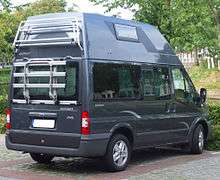Westfalia
Westfalia is the designation of various specially converted Volkswagen camper vans. It is named after Westfalia-Werke, the contractor that built the vans, which is headquartered in the town of Rheda-Wiedenbrück, located in the Westphalia region of Germany.

Westfalia-Werke also converted non-Volkswagen vans, and produced trailers and other products, but they were best known for their Volkswagen camper conversions. Westfalia began converting Volkswagen buses in 1951. Their famous "pop-top" package was added later, and became very popular on the second-generation VW Bus from 1968 to 1979, and its successor the Vanagon, the Sven Hedin and Florida conversions on the Volkswagen LT, and then the T4 EuroVan, which was discontinued in 2003. This design also inspired many imitators, with dozens of other companies worldwide offering pop-top van conversions. Therefore, not all pop-top Volkswagens are Westfalia conversions, although in the United States, the Westfalia conversion was by far the most common. Conversely, not all Volkswagen Westfalia conversions had pop-tops or cooking facilities. Volkswagen offered a "Weekender" package in the 1970s with a Westfalia interior, but no pop-top. Later, some Vanagon conversions were offered with a pop-top and interior table, but lacked cooking facilities and instead included a luggable 12 volt refrigerator.
In 1999, DaimlerChrysler purchased a 49% stake in Westfalia-Werke's van conversion division, and in 2001 absorbed the remaining 51%. Of course, since DaimlerChrysler is a Volkswagen competitor, this spelled the end of the Volkswagen-Westfalia partnership. Volkswagen still offers pop-top camper conversions in Europe, which are made in house since 2005. Vans leave the Transporter/Multivan assembly line and are moved to a dedicated facility to be converted into Californias, in Ocean, Coast or Beach versions. Meanwhile, Westfalia now makes Mercedes Marco Polo pop top vans, as well as larger Sprinter high-roof — factory camper conversions for Mercedes vans, distributed in the United States by Airstream and badged as Dodge Sprinters. They also provide automotive accessories to BMW, including trailer hitches.
In 2008, a management buyout occurred and Westfalia Van Conversion is now an independent entity. It still converts some vehicles for major car manufacturers to sell through their own networks, such as the Ford Nugget, but also markets conversions through its own network of recreational vehicle dealers. These models include the Ford-based Big Nugget, Volkswagen Crafter-based Sven Hedin and the Michelangelo. The Michelangelo vehicle uses a Fiat Scudo chassis and is designed to be a major competitor to the Volkswagen California. Westfalia has recently returned to making their own conversions of Volkswagen Transporter vans, in direct competition with the Volkswagen California.
On 28 January 2010, Westfalia-Werke filed for bankruptcy, citing a 40 percent drop in sales. According to the filing, they would like to keep doing business while they restructure. Westfalia was acquired by the Rapido group in 2011.
Models
| Model | Base vehicle | Produced from | Produced to |
|---|---|---|---|
| Sven Hedin | LT28 | 1977 | |
| Florida | LT28 LT31 | ||
| James Cook | 307D | 1977 | |
| Joker | Transporter | 1978 | |
| Nugget | Transit | 1985 | 2016 |
| California | Transporter | 1988 | 2004 |
| Atlantic | Transporter | ||
| James Cook | Sprinter | 2006 | |
| Michelangelo | Scudo | 2009 | |
| Kepler one | Transporter | Present | |
| Kepler Six | Transporter | Present | |
| Jules Verne | Transporter | Present | |
| Club Joker | Transporter | Present | |
| Columbus | Ducato | Present | |
| Marco Polo | Vito | 1996 | Present |
| Amundsen | Ducato | 2012 | Present |
| Sven Hedin (2) | Crafter | 2017 | Present |
References
- westfalia-mobil.net. "Westfalia – Company history | Westfalia Mobil GmbH". www.westfalia-mobil.net. Retrieved 2017-11-28.
- westfalia-mobil.net. "The new Amundsen marks the entry into the Westfalia class | Westfalia Mobil GmbH". www.westfalia-mobil.net. Retrieved 2017-11-28.
External links
| Wikimedia Commons has media related to Westfalia vehicles. |
- Official website
- Dutch Nugget Register — Unofficial Dutch Web site of Nugget owners
- nuggetforum.de — Unofficial German Westfalia Nugget Community
- https://www.fridgexpress.com/